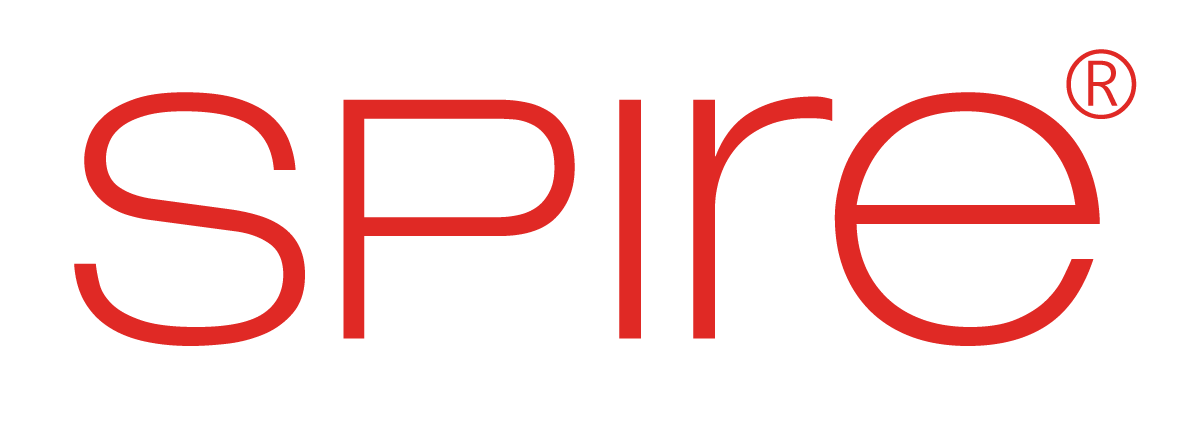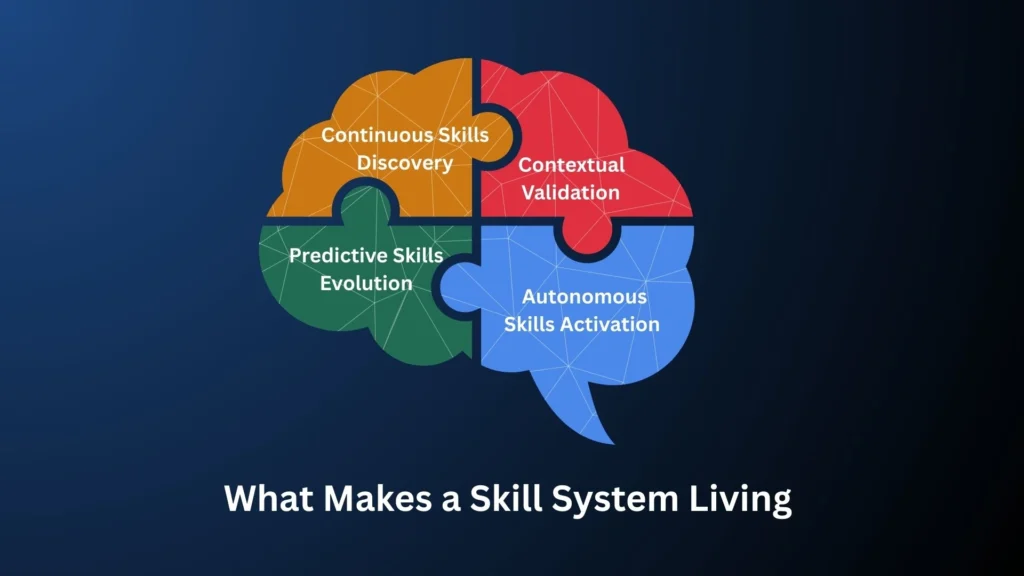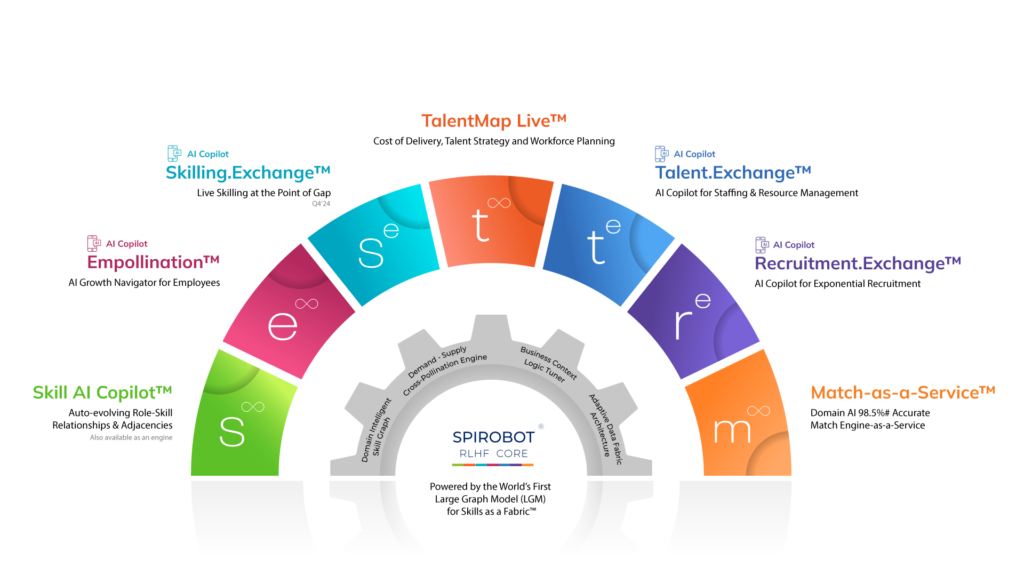In an era of constant disruption, skills are in perpetual motion. The shelf life of technical expertise continues to shrink, hybrid roles are emerging across industries, and entirely new job categories are being created faster than most organizations can anticipate.
Yet despite these shifts, many organizations still manage workforce capabilities with outdated systems, static spreadsheets, rigid taxonomies, and annual self-assessments. These methods can no longer keep pace with today’s velocity of change and prepare organizations for the skills they will need tomorrow.
To stay competitive and resilient, businesses must embrace a new approach: one where skills are treated as living, evolving assets, dynamically mapped and activated to fuel continuous growth.
The future belongs to organizations that can inventory skills in real time, predict skill evolution, and orchestrate capabilities at speed and scale.
The Challenges with Traditional Skills Inventories
Traditional skills inventories were designed for a workforce reality that no longer exists. In a time when roles were narrowly defined, career paths were linear, and change was incremental, it made sense to capture employee skills through static, periodic updates, often during annual performance reviews or training assessments.
Traditional Skills Inventory vs Living Skills System
|
Traditional Skills Inventory |
Living Skills System |
|
Updated annually |
Updated continuously |
|
Self-reported |
Context-validated |
|
Rigid taxonomies |
Adaptive skill graphs |
|
Human-input driven |
AI-sensed signals |
|
Missed internal talent opportunities |
Strategic talent activation through real-time skills visibility |
However, the modern workplace is far more dynamic, and traditional skills inventories are now fundamentally misaligned with organizational needs. Here’s why:
1. Static Snapshots in a Fluid World
Legacy skills inventories typically provide a one-time snapshot of an employee’s capabilities a frozen moment in time. Yet, skills acquisition today is continuous and often informal. Employees are learning new tools, applying cross-disciplinary knowledge, and expanding their capabilities daily through projects, collaborations, and on-the-job problem-solving.
By the time a skills database is updated, often once a year it is already outdated. Organizations relying on static snapshots are making critical workforce decisions based on stale information, increasing the risk of mismatches between talent and business needs.
2. Incomplete and Inaccurate Visibility
Most traditional methods of capturing skills depend heavily on self-reporting or manager assessments. Both approaches are inherently limited:
- Self-reporting bias leads to inflated or underrepresented skill claims.
- Managerial evaluations are subjective and often miss skills acquired outside formal roles, such as side projects, hackathons, or self-initiated learning.
As a result, organizations rarely have a complete, trustworthy view of their internal capabilities. They often overlook hidden talent, underutilize critical skills, and misjudge readiness for strategic initiatives.
3. Rigid, Outdated Taxonomies
Skills taxonomies, the structured lists of skills tied to roles were once useful for standardization. However, in today’s rapidly evolving industries, these rigid frameworks quickly become obsolete. Emerging fields such as AI operations, cybersecurity compliance, green energy innovation, and immersive technology design cannot be neatly mapped onto yesterday’s taxonomies.
New combinations of skills are constantly reshaping job functions, creating hybrid roles that traditional systems are ill-equipped to capture. Without dynamic updating, skill taxonomies act as barriers rather than enablers of talent mobility and growth.
4. Human-Intensive, Error-Prone Processes
Maintaining traditional skills inventories is an administrative burden. HR teams and business leaders spend excessive time collecting, validating, and updating skills information, an effort that is both time-consuming and prone to errors.
Manual processes struggle to keep up with the scale and speed of modern organizations. Worse, the effort often yields diminishing returns: by the time updates are completed, the underlying data is already drifting toward obsolescence.
5. Missed Strategic Opportunities
When skills data is static, incomplete, or inaccurate, organizations miss crucial opportunities:
- They delay critical project staffing because they cannot quickly find the right internal talent.
- They over-invest in external hiring when upskilling or redeploying internal resources could have been more cost-effective.
- They struggle to pivot to new business models or innovation initiatives because they lack visibility into adjacent or emerging skills within their existing workforce.
In an economy where speed, agility, and innovation are paramount, outdated skills management becomes a significant competitive liability.
What the Future Demands: Skills as a Living System
In the future of work which is already unfolding skills cannot be treated as static checklists or rigid labels. They must be understood as dynamic, evolving ecosystems that shift in tandem with business needs, technological innovation, and market disruption.
A living skills system is one that continuously senses, adapts, and grows, just like the organization it supports. To build true workforce agility, organizations must fundamentally reframe how they think about capabilities. It requires moving from occasional, top-down assessments to continuous, context-aware, real-time intelligence.
Here’s what a living skills system demands:
1. Continuous Skills Discovery
Skills must be captured not at fixed intervals, but constantly sourced from live work activities, project deliverables, new certifications, informal learning, mentorship engagements, and even emerging self-taught competencies.
Rather than asking employees to periodically report their skills, systems must autonomously harvest skills signals from real-world performance, recognizing capabilities as they are demonstrated and applied.
The goal: never let workforce capability intelligence go stale.
2. Contextual Skills Validation
Not all skill claims are equal. The mere possession of a certification or a one-time training badge doesn’t guarantee readiness to apply that skill meaningfully.
A living skills system must validate capabilities by assessing:
- Recency (When was the skill last used?)
- Relevance (Was it applied in a core business context?)
- Proficiency (At what level – expert, advanced, proficient?)
- Impact (Did the application of the skill drive measurable outcomes?)
This contextual validation ensures that organizations have a truthful, actionable view of their workforce capabilities, not just an optimistic inventory of past learning activities.
3. Predictive Skills Evolution
A living system doesn’t just capture today’s state; it anticipates tomorrow’s growth.
Using AI-powered modeling, organizations can forecast:
- What adjacent skills an employee is likely to develop based on current projects and learning pathways.
- Which emerging skills will be in high demand across the organization or industry within the next 12–24 months.
- How workforce capability gaps might widen if proactive interventions aren’t made.
By embracing predictive skills intelligence, businesses move from reactive gap-filling to strategic capability building, creating a future-ready workforce before the market demands it.
4. Autonomous Skills Activation
A living skills system doesn’t merely inventory capabilities it activates them.
This means:
- Instantly surfacing hidden talent pools for new opportunities.
- Matching employees to internal gigs, career tracks, or mentorships based on dynamic skills data.
- Triggering timely upskilling or reskilling interventions exactly when needed not months later.
Activation transforms skills from passive data points into active levers of growth, mobility, and innovation.
Why Dynamic Skills Mapping Is the New Growth Imperative
In a world defined by disruption, talent agility has become a critical differentiator. Markets pivot faster, customer needs evolve overnight, and competitive advantages erode in months, not years. In this environment, the ability to dynamically map, mobilize, and grow skills is not a nice-to-have, it’s the foundation for sustainable business success.
Static skills management leaves organizations vulnerable. Dynamic skills mapping, on the other hand, creates a living, real-time view of workforce capability, turning skills intelligence into a source of resilience, speed, and growth.
Here’s why dynamic skills mapping is now a strategic imperative:
1. Powering Agile Workforce Planning
Business conditions are changing at unprecedented speed. Whether it’s entering new markets, launching innovative products, or navigating regulatory shifts, organizations must deploy the right skills at the right time, often with little advance notice.
With dynamic, real-time skills intelligence:
- Workforce planning shifts from annual forecasting to continuous, adaptive modeling.
- Leaders can rapidly assess available capabilities and mobilize cross-functional teams.
- Resource gaps are identified early, enabling proactive reskilling, hiring, or partnerships.
Organizations move from reactive firefighting to strategic talent orchestration, gaining a critical advantage in volatile environments.
2. Accelerating Internal Talent Mobility
Today’s employees seek growth, not just security. When organizations lack visibility into evolving skills, employees feel stuck leading to disengagement, attrition, and lost potential.
Dynamic skills mapping enables:
- Faster, smarter matching of employees to new projects, gigs, and career opportunities.
- Pathways for career mobility that are driven by real capability, not just job titles.
- Early identification of high-potential talent ready for leadership or critical assignments.
The result:
- Higher retention of top performers.
- More inclusive opportunity access across diverse talent pools.
- Stronger internal pipelines for succession and innovation.
Instead of losing talent to external opportunities, organizations unlock potential from within.
3. Transforming Learning and Development into Strategic Investment
Traditional learning programs often waste valuable resources on generalized training that may not align with actual business needs.
With dynamic skills intelligence:
- L&D initiatives can be hyper-personalized to each employee’s evolving profile.
- Learning pathways are aligned with strategic skills gaps forecasted across the organization.
- Training investment yields measurable outcomes tied directly to workforce capability growth.
Organizations no longer just “offer learning” they engineer skill-building at scale, with clear ROI and business impact.
4. Futureproofing Against Continuous Disruption
Perhaps most importantly, dynamic skills mapping future-proofs organizations against the unknown. Industries will continue to be reshaped by technologies like AI, automation, climate innovation, and new business models. Workforce disruptions are inevitable.
Organizations with dynamic, real-time visibility into capabilities can:
- Model potential disruption scenarios.
- Proactively re-skill and redeploy talent to emerging opportunity areas.
- Lead transformation efforts from a position of strength.
Rather than being blindsided by change, they navigate it deliberately and even turn it into competitive advantage.
Bridging the Gap: Why Organizations Need Autonomous Agents
Despite recognizing the need for dynamic skills intelligence, most organizations today face a hard reality: the gap between ambition and execution is widening.
Leaders aspire to build living, real-time maps of their workforce capabilities. They know they must plan workforce strategies around skills, not just roles. They understand that agility demands continuous reskilling and redeployment.
But few have the tools, systems, or bandwidth to make this vision a reality at the scale and speed required.
The truth is:
- Skills are evolving faster than manual systems can track.
- Workforce data is fragmented across HR platforms, project tools, learning systems, and external sources.
- The complexity of validating, updating, and predicting skills manually is overwhelming.
Even the most diligent HR teams, supported by modern HCM suites, cannot match the volume, velocity, and contextual nuance needed to maintain dynamic, trusted skills intelligence across a large, dispersed workforce.
As a result, the gap between dynamic skills strategy and static skills execution keeps growing unless organizations rethink the foundation of how skills are mapped and activated.
Why Humans Alone Can’t Close the Gap
The scale of change is simply too great:
- Thousands of employees dynamically learning and applying new capabilities daily.
- Tens of thousands of projects, tasks, courses, and certifications generating fresh skills signals every month.
- Constantly shifting business priorities, creating new demand for emerging skills.
Manually managing this explosion of skills data, validating proficiency, contextualizing usage, predicting evolution is beyond human processing capacity.
Without automation, organizations are trapped in an endless loop:
- Outdated data
- Reactive planning
- Talent misalignment
- Increased hiring costs
- Growing workforce disengagement
To truly build a living skills ecosystem, organizations need more than just better processes or more people. They need a new operational model powered by trusted, autonomous intelligence.
The Rise of Autonomous Talent Orchestrators
This is where Autonomous Talent Orchestrators enter the scene. These intelligent agents are autonomously sensing, validating, predicting, and activating skills across the workforce, operating continuously, transparently, and within enterprise governance frameworks.
Autonomous agents bridge the gap by:
- Harvesting skills signals in real time from a multitude of enterprise and external sources.
- Contextualizing and validating skills to ensure accuracy and relevance.
- Modeling future skills trajectories, enabling proactive workforce planning.
- Triggering personalized skilling and mobility actions at the point of need.
They act as the connective tissue between business strategy, talent management, and workforce execution, ensuring that skills intelligence is no longer a static report but a living, breathing competitive asset.
Why Now?
Organizations that embrace autonomous agents today gain the ability to:
- Plan and respond with agility amid constant change.
- Unlock internal talent potential with unparalleled visibility.
- Invest smarter in learning and workforce development.
- Build resilience against future disruptions.
Those that delay will find themselves locked in slow, manual cycles, increasingly outpaced by more adaptive, future-ready competitors.
Introducing Agent Sigma™: Autonomous Skills Mapping in Action
Recognizing the growing gap between traditional skills management and future workforce needs, Spire.AI pioneered a fundamentally new approach, one that combines domain expertise, real-time intelligence, and autonomous execution.
Agent Sigma™ is Spire.AI’s Autonomous Talent Orchestrator built specifically to manage workforce capabilities as a living, evolving system.
Powered by Domain-Intelligent AI and Spire.AI’s proprietary Large Graph Model (LGM) for Skills, Agent Sigma™ transforms the theory of dynamic skills mapping into tangible, scalable action. This AI agent orchestrates workforce intelligence autonomously, ensuring that organizations always have an accurate, predictive, and trusted view of their internal capabilities.
Let’s explore how Agent Sigma™ makes dynamic skills intelligence real and why it represents a new era for workforce strategy.
Agent Sigma™ is an enterprise-grade autonomous agent designed to sense, map, validate, and activate skills intelligence in real time, operating within organizational governance frameworks to ensure transparency, compliance, and trust.
Where traditional systems manage static records, Agent Sigma™ creates a living, breathing, continuously evolving capability graph across the workforce.
Here’s how Agent Sigma™ fundamentally transforms skills intelligence:
1. Continuous, Autonomous Skills Discovery
Agent Sigma™ continuously harvests signals across multiple enterprise and external data sources.
- Project assignments and deliverables
- Performance feedback loops
- Certifications and credential achievements
- Learning engagements and course completions
- Informal gig platforms and internal marketplaces
- Labor market dynamics and role evolution trends
Unlike traditional systems that rely on periodic manual updates, Agent Sigma™ autonomously identifies emerging skills and validates them in context as employees complete real-world tasks and projects.
2. Contextual Validation and Proficiency Mapping
Not all skills are created equal, and Agent Sigma™ knows this. Using advanced modeling techniques, it evaluates:
- Recency: How recently was the skill applied?
- Depth: Was it demonstrated at an expert, advanced, or proficient level?
- Relevance: Was the skill critical to a business outcome or ancillary?
- Impact: Did the application of the skill contribute meaningfully to results?
This ensures that skills intelligence is accurate, contextualized, and meaningful, not self-reported or artificially inflated.
3. Predictive Skills Evolution Modeling
Agent Sigma™ doesn’t just map today’s skills it models tomorrow’s capability pathways.
It analyzes:
- Adjacency patterns (skills likely to be acquired based on current roles)
- Cross-disciplinary learning trajectories
- Industry trend forecasting (e.g., AI adoption, ESG regulatory shifts)
This predictive capability enables organizations to build future talent pipelines today, long before gaps become crises.
Real-World Impact: Skills-Driven Growth with Agent Sigma™
The promise of dynamic skills intelligence becomes truly powerful when applied to real-world workforce challenges. From large-scale digital transformations to just-in-time staffing needs, organizations are increasingly constrained by outdated, fragmented, or reactive talent strategies.
Agent Sigma™ closes this gap by transforming how workforce decisions are made in real time, with full visibility into evolving capabilities. The table below outlines how Agent Sigma™ redefines outcomes across four high-impact talent scenarios. In each case, autonomous, context-aware skills intelligence replaces slow, manual processes, unlocking faster decisions, smarter talent deployment, and measurable gains in agility and cost-efficiency.
|
Challenge |
Traditional Approach |
With Agent Sigma™ |
|
1. Preparing for digital transformation |
Reactive hiring to fill gaps |
Proactive internal upskilling and agile redeployment |
|
2. Identifying AI readiness |
Surveys and estimates |
Continuous detection of AI-adjacent skills and predictive reskilling |
|
3. Accelerating project staffing |
Manual skill searches |
Instant talent-to-demand matching based on live skill maps |
|
4. Future-proofing leadership |
Static competency models |
Dynamic skills trajectory mapping for leadership potential |
In every case, dynamic, autonomous skills intelligence enables faster decision-making, lower talent costs, and higher organizational agility.
Conclusion: Future-Proofing Workforce Readiness
The pace of innovation, the emergence of new roles, and the demand for new skills will only accelerate. Organizations that cling to static, manual, outdated skills management practices will be caught unprepared, struggling to fill roles, to reskill workers, and to remain competitive.
Those that embrace autonomous, real-time skills intelligence will thrive with a workforce that is agile, resilient, and ready for whatever the future brings. The question is no longer if organizations should evolve their skills strategies but how fast they can begin.







